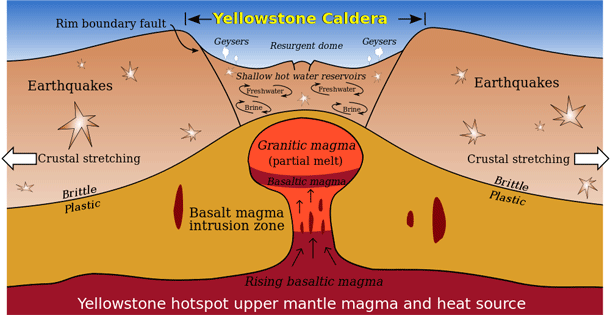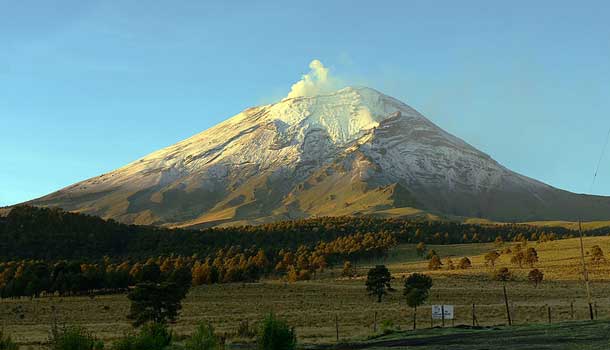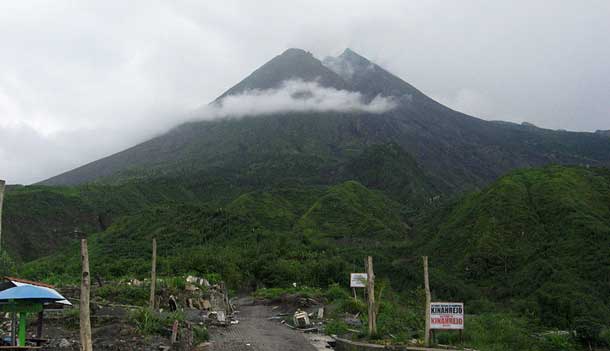At one time,
volcanic eruptions were thought to be a punishment from the Gods.
Nowadays, we
know volcanic eruptions are a result of glowing hot magma being forced up from
the mantle through vents in the earth’s crust. Of course, that doesn’t make
their explosive effects any less devastating.
Here is a list
of volcanoes most likely to erupt and wreak tragedy on surrounding communities
and the environment at large.
NATURE OF HUMAN NATURE
1. Yellowstone Caldera, United
States of America

Yellowstone

The bubbling sulfuric hot
springs and erupting geysers of Yellowstone national park have long attracted
tourists from far and wide. The park is breathtakingly beautiful and awe
inspiring. But underneath the beauty of Yellowstone lies a super-volcano that
has the potential to wipe out the Western United States and alter the course of
human history.
As the name suggests,
super volcanoes are volcanic eruptions that are, well, big. Really big. In
fact, super volcanoes are a phenomenon that has never been observed by mankind.
The last supervolcano explosion we know of occurred 640,000 years ago in
Yellowstone. The first known super volcano explosion 2.1 million years ago was
an incredible 25,000 times larger than the 1980 eruption of Mt. St. Helens
which killed 57 people and hurled volcanic ash around the world.
Unlike traditional
volcanoes, super volcanoes don’t have a cone shaped mountain, instead they form
what are known as calderas – the sunken areas that are left over from previous
super volcano eruptions. Essentially, all of Yellowstone is a giant caldera,
ready to blow and devastate humanity. Experts estimate that a Yellowstone eruption
would kill 87,000 people immediately, while the clouds of ash and gas would
enter the jet stream and have untold effects on the world’s food supply.
2.
Mt. Vesuvius, Italy

Mount Vesuvius in Campagnia,
Italy has a history of activity that makes it one of the world’s most dangerous
volcanoes. It last erupted in 1944, but it usually has an eruption cycle of
just 20 years. Moreover, 3 million people live relatively close to the crater,
as it sits just 5 miles east of Naples. This makes it the most densely
populated volcanic region in the entire world.
Mt. Vesuvius is the
only volcano to have erupted on the European mainland within the last hundred
years, and is probably most famous for its massive eruption in 79 AD, when it
buried the cities of Herculaneum and Pompei.
3.
Popocatépetl, Mexico

Popocatépetl is a large, glacier covered peak
that lies around 35 miles from Mexico City. Around 9 million people live within
Popocatépetl’s blast radius, and it has erupted more than 20 times since 1519.
It last erupted in 2000. Thank fully, preventative evacuations of 41,000 people from surrounding towns prevented a major catastrophe.
It last erupted in 2000. Thank fully, preventative evacuations of 41,000 people from surrounding towns prevented a major catastrophe.
4.
Sakurajima, Japan

This composite volcano in
Japan was once its own island, but lava flows in its 1914 eruption caused it to
connect to the mainland. Many experts refer to it as the “Vesuvius of the
east”, due to its high level of volcanic activity.
Every year, thousands
of small explosions come from Sakurajima’s peak, throwing up ash over the
surrounding areas. However, a major eruption could have deadly consequences for
the 700,000 residents of Kagoshima, who live just miles from the Volcano. The
city even has special volcano shelters where people can go to take cover from
falling debris.
5.
Galeras, Columbia

Located in Southern Columbia
near the border with Ecuador, Galeras has been active for at least 1 million
years. It erupts frequently, with its first recorded eruption dating back to
1580. More alarming is the fact that a city of 450,000 residents – the city of
Pasto – lies on its eastern slope.
While it went dormant
in 1978, it went active again in 1988 after just 10 years. When scientists held
a Decade Volcano conference in 1993 to address the dangers of Galeras, an
unexpected eruption occurred, killing 6 scientists and 3 tourists. Since 2000,
it has erupted almost every year, spouting out ash and lava and causing tremors
in the region.
6.
Mt. Merapi, Indonesia

Translated, Mt. Merapi means
Mountain of Fire, an apt name for the most active volcano in Indonesia, and a
mountain that has produced more lava flow than any volcano in the world. Mt.
Merapi has erupted regularly since 1548 and has been active for the last 10,000
years. Experts believe that its activity led to the demise of the Hindu Kingdom
of Mataram. Currently near its slopes lies the city of Yogyakarta, home to
thousands of inhabitants.
Mt. Merapi’s infamous
lava flows usually travel around 3-4 miles from the peak, though some eruptions
cause lava to flow as far as 8 miles. These lava flows can travel as fast as 70
miles per hour. In 2010, an eruption killed 353 people and left 320,000 local
residents homeless.
7.
Mt. Nyiragongo, Democratic Republic of Congo

Mt. Nyiragongo is one of the
most active volcanoes on the African continent. It’s well known for its large
lava lakes, which frequently appear in its crater. Nyiragongo poses a unique threat
to surrounding communities, as nowhere in the world does a steep sided
stratovolcano carry such a large lake of fluid lava.
In fact, from 1894 to
1977, Nyiragongo’s summit crater was filled with a large, active lava lake.
When the walls of the crater fractured on Jan 10, 1977, the lava lake drained
within an hour, causing massive lava flows of over 60 miles per hour. These
flows quickly overwhelmed local villages, causing several thousand people.
In 2002, another major
eruption at Mt. Nyiragongo caused a lava stream to flow through the provincial
capital of Goma. Fortunately, the 400,000 residents had already been evacuated,
but 147 people still died as a result of the eruption. 4,500 buildings were
destroyed in Goma, leaving 120,000 people homeless. Ensuing tremors destroyed
even more buildings.
8.
Ulawun, Papua New Guinea

Ulawun is one of the most
active volcanoes in Papua New Guinea. Eruptions from Ulawun originate from its
central crater. There have been 22 eruptions recorded at Ulawun since the 1700s.
In recent years, the activity at Ulawun has been consistent, with local
residents constantly witnessing relatively small explosions which deposit ash
and lava in the surrounding areas.
Due to its height, the
biggest threat posed by Ulawun is a catastrophic structural collapse, which
could generate an eruption that would cause devastation to 100s of square km of
surrounding land.
9.
Taal Volcano, Philippines

The Taal Volcano is a cinder
cone volcano. It is located on the island of Luzon, Philippines where it lies
at the middle of Lake Taal. It lies just 31 miles from Manila – the capital of
the Philippines and home to 1.6 million people.
The Taal Volcano has
had 33 recorded eruptions since 1572. While most of these eruptions are
confined to the intracaldera area, some eruptions devastate the entire region
with its fallout. Altogether, it’s estimated that 5,000-6,000 people have been
killed by eruptions at Taal. Even today, the only safe way to view the active
Taal Volcano is from a safe distance. Of course, that doesn’t stop adventurers
from trekking on “Volcano Island”
10.
Mauna Loa, Hawaii

In terms of volume and
surface area, Mauna Loa is the largest volcano in the world. It is also one of
the 5 volcanoes that make up the Island of Hawaii, all the way in the middle of
the Pacific Ocean.
Mauna Loa has been
erupting regularly for at least the past 700,000 years, with its most recent
eruption occurring in 1984. The most significant hazard Mauna Loa poses to
surrounding communities are its lava flows. Although most of the flows from
Mauna Loa advance at a slow pace, posing little danger to human life, major
eruptions can cause fast moving flows. In 1950 for example, the village of
Ho’okena Mauka was destroyed by flowing lava. The intense 1984 eruption saw lava
flows that moved towards the highly populated Hilo, but didn’t reach any
buildings.
Another rarer, but
potentially more devastating hazard posed by Mauna Loa is the potential for
massive landslides triggered by a collapse of the volcano’s flanks. Such a collapse
is rare, but it can cause severe earthquakes and megatsunamis.
Photo BY Wikipedia




0 comments:
Post a Comment